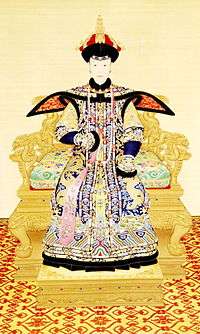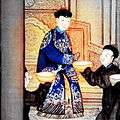Empress Xiaoxianchun
Empress Xiaoxianchun (28 March 1712 – 8 April 1748), of the Manchu Bordered Yellow Banner Fuca clan, was a consort of the Qianlong Emperor.
| Empress Xiaoxianchun | |||||
|---|---|---|---|---|---|
 | |||||
| Empress consort of Qing | |||||
| Tenure | 23 January 1738 – 8 April 1748 | ||||
| Predecessor | Empress Xiaojingxian | ||||
| Successor | Hoifa-Nara, the Step Empress | ||||
| Born | 28 March 1712 (康熙五十一年 二月 二十二日) | ||||
| Died | 8 April 1748 (aged 36) (乾隆十三年 三月 十一日) Forbidden City | ||||
| Burial | Yu Mausoleum, Eastern Qing tombs | ||||
| Spouse | |||||
| Issue | First daughter Yonglian Princess Hejing of the First Rank Yongcong | ||||
| |||||
| House | Fuca (富察; by birth) Aisin Gioro (by marriage) | ||||
| Father | Lirongbao (李荣保) | ||||
| Mother | Lady Gioro | ||||
| Empress Xiaoxianchun | |||||||
|---|---|---|---|---|---|---|---|
| Chinese name | |||||||
| Traditional Chinese | 孝賢純皇后 | ||||||
| Simplified Chinese | 孝贤纯皇后 | ||||||
| |||||||
| Manchu name | |||||||
| Manchu script | ᡥᡳᠶᠣᠣᡧᡠᠩᡤᠠ ᡝᡵᡩᡝᠮᡠᠩᡤᡝ ᠶᠣᠩᡴᡳᠶᠠᠩᡤᠠ ᡥᡡᠸᠠᠩᡥᡝᠣ | ||||||
| Romanization | hiyoošungga erdemungge yongkiyangga hūwangheo | ||||||
Life
Family background
Empress Xiaoxianchun's personal name was not recorded in history.
- Father: Lirongbao (李榮保; 1674–1723), served as a third rank military official (總管) of Chahar, and held the title of a first class duke (一等公)
- Paternal grandfather: Mishan (米思翰; 1633–1675), served as the Minister of Revenue from 1669–1675
- Paternal uncle: Maci (1652–1739)
- Mother: Lady Gioro
- Seven elder brothers and two younger brothers
- Ninth younger brother: Fuheng (1720–1770)
- One younger sister
Kangxi era
The future Empress Xiaoxianchun was born on the 22nd day of the second lunar month in the 51st year of the reign of the Kangxi Emperor, which translates to 28 March 1712 in the Gregorian calendar.
Yongzheng era
On 3 September 1727, Lady Fuca married Hongli, the fourth son of the Yongzheng Emperor, and became his primary consort. She then moved into the Palace of Eternal Spring in the western part of the Forbidden City. She gave birth on 3 November 1728 to Hongli's first daughter, who would die prematurely on 14 February 1730, on 9 August 1730 to his second son, Yonglian, who would die due to small pox on 23 November 1738, and on 31 July 1731 to his third daughter, Princess Hejing of the First Rank.
Qianlong era
The Yongzheng Emperor died on 8 October 1735 and was succeeded by Hongli, who was enthroned as the Qianlong Emperor. On 23 January 1738, Lady Fuca, as the emperor's primary consort, was instated as Empress.
That same year the Death of Crown Prince Yonglian struck, the Empress was left heartbroken but since she was the role model of the inner court, she remained strong and continued her duties as Empress of the Great Qing and Fuca Clan but deep inside she was filled with sorrow as her son's death still lingered in her mind for many years. She still did her duties as Empress and remained composed and virtuous but deep inside she was filled with sorrow as her son's death still lingered in her mind for many years. She managed to hide the fact that she was upset from everyone but one, her mother-in-law, Empress Dowager Chongqing, who mentioned once that the Empress' eyes often looked sad.
In the Draft History of Qing, Lady Fuca is described as a respected and virtuous person. She looked after the Qianlong Emperor and the people in the palace, and served her role as Empress well. She was praised and favoured by the emperor.[1] It is also said that Lady Fuca did not like spending money for her own good. Instead of wearing jewellery, she would wear artificial flowers in her hair. The Qianlong Emperor once told her a story that Manchus were too poor to make their own pouches from cloth and had to settle for simple deer hide instead. She immediately made one for him. He was touched by the gift. Lady Fuca also made other pouches for him.[2]
Lady Fuca took her duties seriously when it came to Confucian rituals. As head of the women's quarters in the palace, she supervised the emperor's consorts when performing a ritual. One of these was a rite concerning sericulture that was presided over by the Empress. This rite, which had been practised since the Zhou dynasty, was gradually restored during the reign of the Qianlong Emperor. For the purpose of this rite, a sericulture altar was constructed in 1742. In 1744, a new Altar to Sericulture was completed,[3] largely at Lady Fuca's urging.[4] That year, Lady Fuca became the first empress in the Qing dynasty to personally lead the women in the palace in these rites. They made offerings of mulberry and presented them to silkworm cocoons, all of them working industriously. The whole rite was painted on four scrolls in 1751 in memory of Lady Fuca.[5]
On 27 May 1746, Lady Fuca gave birth to the emperor's seventh son, Yongcong, Emperor Qianlong had high hopes for Yongcong and crowned him Crown Prince shortly after his birth. However, Yongcong too would die prematurely on 29 January 1748 due to small pox, similar to Yonglian. The death of Yongcong caused the Empress to be heartbroken once more, all hope for Empress Fuca collapsed, the death of her second son left her depressed and also deteriorated her health.
Death
In 1748, during one of the Qianlong Emperor's southern tours, she became seriously ill and eventually died on 8 April, 3 months after the death of Yongcong. The Empress' funeral was lavishly done. The Emperor was deeply affected and did not take it well. When he found out that two of his sons did not mourn for the Empress, he came out with a decreed that the both of them would not be allowed to ascend the throne. Court Officials who shaved their hair, which was considered disrespectful as you are not allowed to shave your hair throughout the mourning period were either heavily punished or executed.
Titles
- During the reign of the Kangxi Emperor (r. 1661–1722):
- Lady Fuca (from 28 March 1712)
- During the reign of the Yongzheng Emperor (r. 1722–1735):
- Primary consort (嫡福晉; from 3 September 1727[6])
- During the reign of the Qianlong Emperor (r. 1735–1796):
- During the reign of the Jiaqing Emperor (r. 1796–1802):
- Empress Xiaoxianchun (孝賢純皇后; from 1799)
Issue
- As primary consort:
- The Qianlong Emperor's first daughter (3 November 1728 – 14 February 1730)
- Yonglian (永璉; 9 August 1730 – 23 November 1738), the Qianlong Emperor's second son
- Princess Hejing of the First Rank (固倫和敬公主; 31 July 1731 – 30 September 1792), the Qianlong Emperor's third daughter
- Married Septeng Baljur (色布騰巴爾珠爾; d. 1775) of the Khorchin Borjigit clan in April/May 1747
- As Empress:
- Yongcong (永琮; 27 May 1746 – 29 January 1748), the Qianlong Emperor's seventh son
Gallery
 Empress Xiaoxianchun fondling silkworms
Empress Xiaoxianchun fondling silkworms
In fiction and popular culture
- Portrayed by Shally Tsang in Take Care, Your Highness! (1985)
- Portrayed by Chan Fuk-sang in The Rise and Fall of Qing Dynasty (1988)
- Portrayed by Chen Yi in Jiangshan Weizhong (2002)
- Portrayed by Joyce Tang in The Prince's Shadow (2005)
- Portrayed by Yuan Yi in Empresses in the Palace (2011)
- Portrayed by Qin Lan in Story of Yanxi Palace (2018)
- Portrayed by Dong Jie in Ruyi's Royal Love in the Palace (2018)
See also
- Ranks of imperial consorts in China#Qing
- Royal and noble ranks of the Qing dynasty
Notes
- Qing Shi Gao vol. 214.
- Ho & Bronson (2004).
- Naquin (2000), p. 308.
- Qing liechao houfei zhuan gao, F. 86. Qingchao yeshi daguan, 1.55.
- The painting "Empress supervising the rites of sericulture" hangs in the Palace Museum, Beijing.
- 雍正五年 七月 十八日
- 乾隆二年 十二月 四日
- 乾隆十三年 五月 二十一日
References
- Ho, Chuimei; Bronson, Bennet (2004). Splendors of China's Forbidden City: The Glorious Reign of Emperor Qianlong (Illustrated ed.). Merrell. ISBN 1858942039.
- Kutcher, Norman (August 1997). "The Death of the Xiaoxian Empress: Bureaucratic Betrayals and the Crises of Eighteenth-Century Chinese Rule". The Journal of Asian Studies. 56 (3): 708–725. doi:10.2307/2659606.
- Naquin, Susan (2000). Peking: Temples and City Life, 1400–1900. University of California Press.
- Wan, Yi; Shuqing, Wang; Yanzhen, Lu; Scott, Rosemary E. (1988). Daily Life in the Forbidden City: The Qing Dynasty, 1644-1912 (Illustrated ed.). Viking. ISBN 0670811645.
- Zhao, Erxun (1928). Draft History of Qing (Qing Shi Gao) (in Chinese).
| Chinese royalty | ||
|---|---|---|
| Preceded by Empress Xiaoshengxian (Empress Xiaojingxian was the actual predecessor) |
Empress of China 1738 – 8 April 1748 |
Succeeded by Hoifa-Nara, the Step Empress |